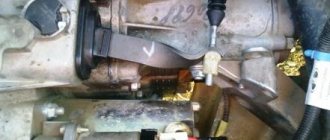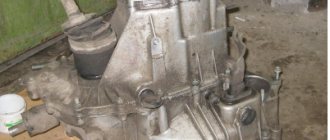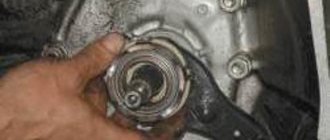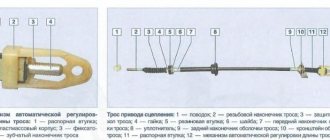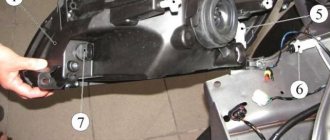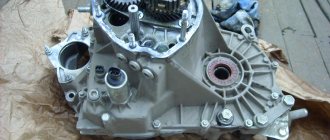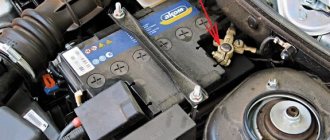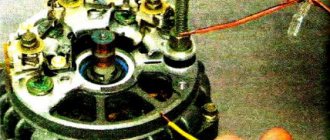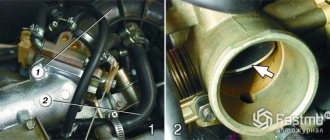Lada K alina 2 . REPLACING TRANSMISSION CONTROL CABLES
You will need: pliers, a 13mm socket.
The designs of control drives for automatic or manual transmissions are fundamentally the same. The difference is in the number of cables (a manual transmission has two, and an automatic transmission has one) and in the way the cables are attached to the automatic transmission's multifunction switch levers and the manual transmission's shift mechanism. The operation is shown using the example of a car with an automatic transmission. The differences in methods for replacing manual transmission control drive cables are specifically discussed.
1. Perform steps 1-9 of removing the automatic transmission selector lever
the selector lever for controlling an automatic transmission and the control lever for a manual transmission,” p. 158). 2. Remove the tip of the gearbox control cable from the rocker lever pin, overcoming the elastic resistance of its clamp.
On a car with a manual transmission, similarly disconnect cable 2 (see Fig. 6.4) and gear shift cable 3 from the rocker levers.
3. Press the lock of the end of the transmission control cable sheath.
eleven. . and remove the tip from the bracket on the gearbox. On a car with a manual transmission, the ends of the cable sheaths are not equipped with special clamps. They are rubberized and held in the slots of bracket 1 (see Fig. 6.4) on the gearbox only by tension. 12. Remove the cables from holders 5 (see Fig. 6.4) on a car with a manual transmission or 4 (see Fig. 6.10) on a car with an automatic transmission.
13. Remove the seal of 4 (see Fig. 6.4) cables from the hole in the front panel on a car with a manual transmission or 2 (see Fig. 6.10) on a car with an automatic transmission and remove the cables
14. Install the parts in the reverse order of removal.
15. Adjust the gearbox control drive (see “Adjusting the drive
Tools:
- Driver for socket attachment
- Extension for the end attachment on the wrench
- 8mm wrench attachment
- 10mm wrench attachment
- Ratchet wrench
- 13 mm head
- Open-end wrench 13 mm
- 13 mm straight box spanner
- Small flat screwdriver
- Large flat screwdriver
- Circlip Pliers
- Pliers
- Calipers
Parts and consumables:
- Chalk
- Aerosol lubricant type WD-40
- Lubricant LSC-15
- Tie rod end bushings and damper (if required)
- Plastic shifter shaft washers (if necessary)
- Shift lever ball joint (if required)
Notes:
Remove and disassemble the transmission control mechanism to replace the plastic washers on the gear shift shaft and ball joint. Carry out the work on an inspection ditch or overpass.
1. Remove the middle mudguard as described in this article.
2. Inside the car, overcoming the resistance of the latches, use the yoke to remove the frame for fastening the gear lever cover from the hole in the floor tunnel.
Removing the gear shift cover frame:
1 – gear shift lever cover with frame;
2 – floor tunnel lining.
3. Slide the cover along with the frame along the gear shift lever.
4. Turning the cover inside out, unwind the insulating tape covering the lever cover (during subsequent assembly, the insulating tape can be replaced with a plastic clamp).
Operations for removing the gearbox from a Lada Granta car
The gearbox is heavy and its shape does not have the correct contours, which is why it is best to carry out the work with at least two people.
1. Disconnect the wire from the negative terminal of the battery.
2. For ease of operation, remove the air filter.
4. Raise the car on a lift or hang its front part and place it on reliable supports (if you are working on an inspection ditch). For ease of operation, you can remove the front wheels.
6. If the gearbox is removed for repairs, drain the oil from it
7. Remove the four bolts securing the front clutch housing cover.
8. and remove the cover.
Read:
9. Disconnect the front suspension arms from the steering knuckles by unscrewing two bolts securing the ball joints to the knuckles on both sides of the car.
10. Leaning the mounting blade on the gearbox housing, press the left inner joints out of it.
11. and right-hand drive of the front wheels. Move the drives away from the transmission by moving the corresponding front suspension shock absorbers outward.
The movement of the shock absorber struts is prevented by the steering rods. To eliminate their influence, when disconnecting the right-hand drive from the gearbox, turn the steering wheel all the way to the left, and when disconnecting the left-hand drive, turn it to the right.
Disconnect the right drive only after removing the front cover of the clutch housing (see paragraphs 7 and 8), otherwise the mounting blade can bend the cover and the flywheel will touch it.
Do not disconnect both drives at the same time, as in this case the axle gears in the differential may move and it will be impossible to install the drives without disassembling the transmission . If it is necessary to disconnect both drives after disconnecting one of them, insert a technological plug or the old internal joint housing in its place and tie the plug or housing to the gearbox with wire so that they do not fall out when removing the box. After this, disconnect the second drive.
12. Disconnect the wiring harness connectors from the reverse light switch.
Grant gearbox cables
Removing the cable
at the cable gear selection
of the Grant gearbox
.
Removing manual transmission 2181 with cable drive
This video shows the process of removing the transmission
.
13. and from the speed sensor.
14. Unscrew the nuts of the two bolts securing the torque arm to the gearbox and remove the bolts.
15. and move the rod down along with the bracket,
16. Mark in any way the relative position of the transmission control rod and the shank of the gearshift rod hinge so that when reinstalling, maintain the drive adjustment.
17. Loosen the tightening of the nut of the clamp bolt securing the transmission control rod.
18. and disconnect the rod from the gear shift rod joint.
19. Disconnect the lower end of the clutch cable from the gearbox (see “Replacing and adjusting the Lada Granta clutch cable”).
20. Remove the rear bolt securing the ignition coil bracket.
21. Remove the two upper bolts securing the transmission to the engine, simultaneously securing the second support bracket. Bolt A (front in the direction of travel of the car) is short, bolt B is long. Move the throttle cable together with the bracket to the side.
When is it necessary to change the clutch cable?
As a rule, replacing the cable is necessary when it breaks or is stretched too much (adjusting the cable does not allow normal operation of the clutch).
In this case:
- the clutch pedal becomes tight;
- the pedal stroke changes;
- squeezing the clutch is also difficult;
- the clutch pedal falls to the floor;
As a result, gears are difficult to engage, and a crunching noise may appear in the gearbox when shifting. Please note that ignoring the problem, as well as active attempts to “stick” the gear with a crunch while driving and other efforts that the driver makes when trying to change gears with a faulty clutch, can cause severe wear of the synchronizers and other elements of the gearbox. This means that there is no need to delay replacing the cable.
Moreover, this procedure is not complicated and can be done with your own hands in a regular garage. The only caveat is that you have to work in the area of the pedal assembly, which is not entirely convenient (the fuse box and power steering are in the way).
Procedure for removing/installing an automatic transmission on a Lada Grant
Required materials and tools:
- a set of car keys;
- heads, ratchet;
- rags;
- extension cord, additional lighting;
- screwdrivers with different tips;
- pliers, side cutters;
- hydraulic stop / telescopic stand;
- metal brush;
- new gear oil;
- hydraulic jack / any other lifting mechanism;
- graphite-based lubricant;
- rubber / silicone hose for draining waste;
- wooden stops;
- gloves.
What tools will you need?
If the Grant clutch pedal is too tight or, conversely, has completely failed, and the Grant clutch does not work properly, you will need to change the cable. By the way, a breakdown of the clutch fork will lead to exactly the same symptoms.
To replace the clutch cable you will need:
- open-end wrench at “8”, as well as at “10”;
- a knob (for the end cap) and a knob attachment “10”;
- a pair of Phillips screwdrivers (wide and medium), a flat screwdriver;
- ruler and caliper or ruler
Catalog numbers and a list of all necessary parts
Catalog numbers of bearings, their cost
| Name | vendor code |
| F-846067-01 (dimensions 56 x 86 x 25) | From 1290.00 |
| F846067-00 | —/— |
| F846067-02 | —/— |
| NA4912NBS | 1706.88 |
| 61912ISB | 1272.96 |
*prices are current as of November 26, 2018.
Before replacing an automatic transmission, always confirm the catalog numbers with service station specialists.
How to remove rattling gearshift knob (cable manual transmission 2181) Lada Granta and Lada Kalina
Since 2013, AvtoVAZ began installing a modernized manual cable transmission with the manual transmission index 2181 on Lada Kalina and Granta cars. According to the auto giant, modifications to the gearbox made it possible to reduce backlash and make gear shifts clearer. But in practice, car enthusiasts began to notice that the gearshift knob was rattling.
In 2013, Lada dealers began to receive numerous complaints from Granta and Kalina owners. Drivers were pointed out a problem with the gearshift knob: when it shakes and vibrates (especially in 3rd and 4th gears), crackling and knocking noises appear. AvtoVAZ issued instruction No. 31-13 (To download files you need to log in to the website), which stated that in order to solve the rattling of the gearbox knob, it is necessary to replace the gear shift mechanism. But this did not help, nor did replacing the gearbox cables.
At the same time, enthusiasts began to get involved in solving the problem and tried to eliminate the rattling of the gearshift knob with the help of modifications. For example, they put two springs on the cables near the gear shift mechanism, or put polyethylene in the plastic clip of the lever tip, but this also did not bring the desired result.
Soon AvtoVAZ finds another solution to the problem, which it describes in a new information letter No. 23-15 (To download files you need to log in to the site). The modification of the design consisted of placing a damper (dimensions 30x30x50 mm) under the right cable in the tunnel. Dense foam rubber can be used as a damper, which restores its shape after compression.
In October 2016, AvtoVAZ issued another information letter No. 64-16 “On eliminating chatter in the gearbox control drive of LADA vehicles equipped with a cable gear shift drive.” Now, whoever complained about the rattling of the gear shift lever in the control drive, it was proposed to replace the gear shift cables and their mounting bracket.
However, car enthusiasts have found another effective way to remove the rattling of the gearbox handle - tighten the cables with plastic ties. In some cases, it will be sufficient to tighten the two cables together in the engine compartment at the edge of the heat shield.
If the cracking does not stop, further tighten the cables inside the passenger compartment, and then tighten them to the metal plate. Do not overdo it, otherwise the gear knob will be too tight. It is worth noting that the use of plastic ties solves the problem of vibrations and rattling of the gearshift knob in most cases.
Have you encountered a similar problem? How did you manage to get rid of extraneous noise and vibrations? Let us remind you that another popular modification for Lada cars is the installation of additional door seals and firmware for the standard radio.
Procedure for removing a manual transmission
Required materials and tools:
- set of car keys, sockets, ratchet;
- rags;
- additional lighting;
- jack;
- graphite lubricant;
- plastic container for draining waste;
- transmission oil.
Step-by-step instructions for replacing a manual transmission
- We install the machine within the perimeter of the repair area: on an inspection hole, on a road overpass.
- We remove the terminals from the battery, preventing a short circuit in the circuit.
- We dismantle the air filter and the plastic air filter housing.
- We unscrew the fastening nuts, remove the power terminals, and dismantle the starter.
- We unscrew the mudguards and the oil pan protection (if any).
- Remove the block with wires from the reverse activation sensor.
- Disconnect the contacts from the speed sensor.
- We twist the drain plug and drain the waste from the manual transmission.
- Disconnect the clutch cable, lever fork, and bracket from the gearbox housing.
New - well forgotten old
The modernized gearbox received the index 2181 and the same gearbox. The volume of oil poured has decreased by almost a third. “Mineral water” was exchanged for semi-synthetics, which retains its properties in cold temperatures down to -42 0 C, and does not require replacement for almost 200 thousand km. Suddenly.
Multi-cone synchronizers appeared on first and second speeds for good reason: their mission is to extend the life of the constantly loaded second gear and reduce the effort when changing gears.
The gear change mechanism has become a separate module. To dismantle it, it is not necessary to remove the Lada Granta box. A special lock prevents erroneous start of the reverse mode when turning off fifth gear. Innovation – selector grid: sets the lever stroke when selecting gears, repeating the shift pattern.
The main character in selecting the characteristics of the mechanism turned out to be... a simulation stand. The test driver engages the gears, and the robot simulates shifts. Taking into account the optimal settings, we created a mathematical model for the manufacture of another innovation - a 3D central plate, proposed instead of return locks and springs.
The rocker drive for gear changes was replaced by a cable.
As a result, we got a clear shift pattern, eliminated the interaction of the gearshift lever and seat cushions, and got rid of blocking when selecting reverse gear.
Differences between cable-shift and rocker-shift gearboxes
In gearboxes with rocker shifting, the desired speed is selected using a multi-lever assembly mechanism that connects the handle and the rod that fits the box. An example of such a gearbox is AvtoVAZ 2180.
With cable switching, the variable speed drive with rods gave way to cables.
Cable shift gearbox
By replacing rigid rods with flexible cables, vibrations of the body and gear lever decreased, backlash decreased, and shifts became clearer.
When to remove cables
The Lada Granta has a cable gear change mechanism that is more capricious than the rocker “brother”. During operation, carefully monitor the condition of the unit. Be sure to adhere to the “culture” of gear shifting. Jerks are detrimental to synchronizers and gears. The cables will also get it.
For some, removing the Grants gearbox cables will seem like an easy procedure, for others it will seem like a labor-intensive process, a la removing the gearbox on a Lada Granta. Such work is often carried out at a technical service station (STS). The cables are replaced in pairs.
Catalog numbers, bearing names
Replacing an automatic transmission with a manual transmission and vice versa: how justified is it?
The question is ambiguous, since each owner must start from his goals. When it comes to aggressive driving style, drifting, etc., you can’t find a better mechanic.
If you are a supporter of a smooth ride, medium speeds, and fuel economy, then an automatic is the best choice. Although, if you have the skills, you can drive it on the automatic type.
The final choice is up to the owner of the technical device.
What tools will you need?
If the Grant clutch pedal is too tight or, conversely, has completely failed, and the Grant clutch does not work properly, you will need to change the cable. By the way, a breakdown of the clutch fork will lead to exactly the same symptoms.
To replace the clutch cable you will need:
- open-end wrench at “8”, as well as at “10”;
- a knob (for the end cap) and a knob attachment “10”;
- a pair of Phillips screwdrivers (wide and medium), a flat screwdriver;
- ruler and caliper or ruler
Reviews
| № | Positive |
| 1. | Vladimir: after two years of active operation, there are no complaints about the operation of the manual transmission. I carry out technical inspections in a timely manner, fill in semi-synthetic oil, medium speed limits, non-aggressive driving style. |
| 2. | Sergey: after driving a car for a year and a half, I will say the following: there were no major breakdowns, nor any unscheduled repairs. However, twice I independently tightened the drive cable on the lever. |
| 3. | Kirill: I took a Granta with an automatic rifle from the showroom, the car is playful, good acceleration dynamics, average fuel consumption. The build quality is satisfactory, spare parts are always available in the market and stores. |
| 4. | Dmitry: I recently underwent scheduled maintenance, the master assured me that the transmission was in good working order. Replaced consumables, filter, oil. I have been actively using the car for two years now. The manufacturer indicates a resource of 180 - 200 thousand km before major repairs. Let's see how much mine comes out. |
| 5. | Vasily: at 65,000 km I replaced the rubber boot once, since the previous one was defective. There were no other breakdowns, consumables were replaced as usual. |
| 6. | Ivan: my positive review of the Lada Granta car. This is my second year of driving actively, and in a month I hit two months’ worth. I'm pleased with the build quality of the transmission, no complaints. |
| 7. | Vitaly: the manufacturer recommends changing the transmission oil every 60,000 km, in practice my interval is 50,000 km. I believe that the fresher the oil, the more useful substances are retained in it to protect and lubricate the gearbox gears. |
| Negative | |
| 1. | Ivan: I do not agree with the manufacturer’s statements about the service life of 180,000 km. Already at 80,000 km the cable drive was replaced. In the process, other minor breakdowns were eliminated. The model is crude, there are many shortcomings and defects that are not eliminated from year to year. |
| 2. | Vasily: after 75,000 km, my automatic transmission began to change gears with a certain delay (pause). After visiting a service station, the technician diagnosed a defect in the control unit and solenoid. |
| 3. | Gennady: in general, the transmission is good, but there are a number of shortcomings and defects that need to be eliminated. In order not to be fooled in the future, I plan to buy a Renault Logan. The model is proven, the weaknesses are known, there are not so many of them. |
Conclusion The design of a standard transmission is quite complex, regardless of whether it is manual or automatic. In case of repairs and preventive maintenance, prepare thoroughly and study the methodological recommendations.
When it comes to major transmission repairs, use the services of service station professionals. At a special diagnostic stand, technicians conduct tests and calibrate the operation of the box. Upon completion, they provide a quality guarantee for the block of work performed.
Recommendations
- As a rule, the clutch “disappears” when the clutch fork breaks or the cable breaks.
In such a situation, you can drive your car to the service center without using the clutch pedal. To do this, turn off the engine, engage first gear, then start with the gear engaged. To upshift, you need to re-gear, and to downshift, you need to wait until the engine speed drops to suitable values. We also recommend reading a separate article on how to drive without a clutch. In this article you will learn how to get to the repair site with a broken clutch. - Usually the cable threads break at the base of the pinch.
Some car enthusiasts attach the clutch cable lead to bearings to avoid bending it. The result is increased reliability and increased service life of the cable. When replacing the cable, the plastic insert is removed from the old cable and placed on the new cable. If this is not done, the plastic on the new cable will quickly break. - If the Grant clutch is being replaced, the gearbox or engine is being removed, experienced car enthusiasts recommend replacing the clutch cable if the cable has traveled more than 30-40 thousand km. Also on the Granta, clutch adjustment and inspection are necessary if even minor problems appear with the clutch pedal or difficulties with gear shifting.
ROPE DRIVE
Despite the simplicity and low price, almost all manufacturers abandoned the rod drive, like on the old box. Today, designs of several rods with complex scenes are used to dampen vibrations on the lever, or a more expensive and convenient cable drive. AVTOVAZ experimented with the latter back at Samara, purchasing parts from. But with the switching mechanism located at the bottom, the performance of such a circuit is problematic, and the price of components was scary at that time. Work on the cable-driven gearbox continued as part of other projects, but the production model could only be realized now.
How to change the fluid in a VAZ Granta machine?
Recently, significant changes have occurred in the Russian automotive industry. The AvtoVAZ company managed to equip its cars with an automatic transmission. One of the first models to have an automatic transmission was the Lada Granta. It received technical characteristics similar to international standards.
Grant was equipped with a Yatko machine gun. The box turned out to be very resistant to difficult operating environments. Since last year, the machine began to be produced only in a luxury configuration. An inexpensive “robot” was installed on other Grants. Visually, the Lada Granta with automatic transmission has no differences from its relative with manual transmission. But its fuel consumption is higher.
7_no_copyright
1 — gear selector levers;
2 — selector grid pin;
3 — selector grid;
4 — reverse locking mechanism;
5 - central three-dimensional plate.
However, the developers are not delaying documentation on the hydraulic drive and plan to launch it into series. As well as other improvements, by the way, which for various reasons were not implemented this time. For example, a multi-cone synchronizer in third gear and an equally interesting solution that makes the transition to the fourth and fifth stages clearer and more enjoyable. Not otherwise, appetite comes with eating. By the way, the food turns out delicious - I tried it myself. The main thing I would like to wish to the developers is not to be late with changing dishes. And to consumers - bon appetit!
Thank you for your help in preparing the material.
How to completely renew the lubricant
To completely change the oil, the car owner must:
- Repeat the steps described in the previous block “Draining old fluid”.
- You will only need to fill in half a liter of fresh lubricant.
- Then disconnect the return hose and extend it. Place one end in a large basin or stick it into a five-liter bottle with the other and attach it back to the return fitting.
- Ask your partner to start the engine. Now you need to watch the oil pouring into a basin or bottle.
- When it changes color to a lighter color, ask your partner to turn off the engine.
- Now you need to repeat all the steps that were described in the instructions for a partial oil change. That is, the car owner will need to remove the pan and clean it, replace the old filter device with a new one. Install everything back. The main thing is not to forget to apply sealant in the place where the pan gasket is connected to the bottom of the automatic transmission.
- Fresh lubricant must be added in small portions - 1 liter each.
- Start the engine, press the brake pedal, move the gear shifter through all positions. Keep the engine running and check the level.
- In total, a full shift should take five liters of lubricant.
Read
Full and partial oil change in automatic transmission Honda Accord 7
Now the Lada Granta car owner will be able to drive another sixty thousand kilometers without maintenance.
Symptoms of malfunction, diagnostics, solutions
| Sign | Cause and remedy |
| Incomplete engagement of the clutch (slips) | Replacing discs, cleaning clutches |
| Incomplete shutdown (leading) | Prevention of the clutch mechanism |
| Periodic jerks | Clutch cable wear, clutch replacement |
| Vibration, beating when shifting to higher gears | The flywheel is bent, the gripper teeth are worn out. Replacing the flywheel and related consumables |
| Noise, creaking, grinding noise when activated | Damper spring wear, replacement with a new one, drive lubrication |
| Pedal free play is increased, exceeding 2 -3 mm | Tensioning the cable, replacing with a new one |
| You can hear the smell of burnt friction linings | Dismantling the clutch block, replacing worn elements |
| Increased fuel consumption | Flywheel worn, teeth damaged |
| Reduced acceleration dynamics | Replacing clutches |
SYNCHRONIZER
So, the gear part remains the same. Almost the same: in first and second gears, we still had to install multi-cone synchronizers. Firstly, for the sake of reliability: the second stage is the most loaded, and the multi-cone will undoubtedly extend its life. Secondly, to reduce the effort when shifting gears. In addition, they plan to install the VAZ-2181 gearbox on models with more powerful engines. Therefore, a clutch with a larger diameter (215 mm) is required, which naturally has a larger moment of inertia. This is an additional argument in favor of a multi-cone synchronizer. A more powerful clutch required a different housing, because the previous one accommodated a maximum of 200 mm disc. The starter also had to be moved; now it is located not along the box, but along the engine.
The first samples were equipped with a three-cone synchronizer. But calculations have shown that double-cone, cheaper ones, can withstand the required torque with a margin (see pictures). Among other advantages, they made it possible to get rid of the problematic cone on the gears of the first and second gears, which is in contact with the synchronizer ring and requires high precision in manufacturing. The ring set now creates two friction surfaces for smooth and efficient synchronization. In addition, the German manufacturer (Ho¨rbiger) applies an additional coating to the intermediate ring, which reduces wear and ensures stable operating parameters, including the required coefficient of friction.
To make shifting easier, the bevel angle of the synchronizer teeth was reduced (from 125 to 100º) and the preload force (from 150 to 70 N). If the developers had kept the same single-cone assembly with these changes, it is possible that a crunch would have appeared when the second stage was quickly implanted (especially at low temperatures) - the so-called synchronizer breakdown. This will not happen with a multi-cone due to the larger working surface.
Structure of VAZ-2110 (A) and -2181 (B) gearbox synchronizers:
1_no_copyright
1 - main gear drive gear;
2 - secondary shaft;
3 - input shaft;
4 — fifth gear fork;
5 — fork for selecting third and fourth gears;
6 — reversing light switch;
7 — clutch housing;
8 — gear shift mechanism;
9 - central lock.
Disassembling the mechanism
In order to repair the automatic transmission selector, it is necessary to disassemble it after dismantling. To do this, it is recommended to adhere to the following sequence:
- Unscrew all screws connecting the housing;
- Effortlessly separate the body into halves;
- Wash all parts from dirt and oxides;
- If necessary, it is necessary to clean the contacts with fine sandpaper.
If the tracks are destroyed, it is better to replace the contact group with a new one. During disassembly, avoid getting debris and abrasive objects inside the selector. If necessary, it is recommended to put marks to facilitate subsequent assembly.
Automatic transmission repair JF414E
Scheduled repair of the JF414E automatic transmission allows you not only to eliminate current breakdowns, but is also an excellent preventive measure for the occurrence of serious malfunctions of the machine. Every 100 thousand kilometers, the automatic transmission is opened, all seals, gaskets, worn discs are replaced, the donut is restored and the clutches are changed.
It may be necessary to replace the brake band or rebuild the iron part. It is recommended to change the oil filters every time the machine is opened, and also clean the heat exchanger.
The overhaul includes restoration and replacement of the oil pump, cleaning of the valve body, replacement of solenoids and reassembly of iron. Typically, such work is required at a mileage of 300 thousand kilometers, but if the driver abuses the aggressive driving style of the car, then such repairs need to be carried out at 200 thousand or earlier.
